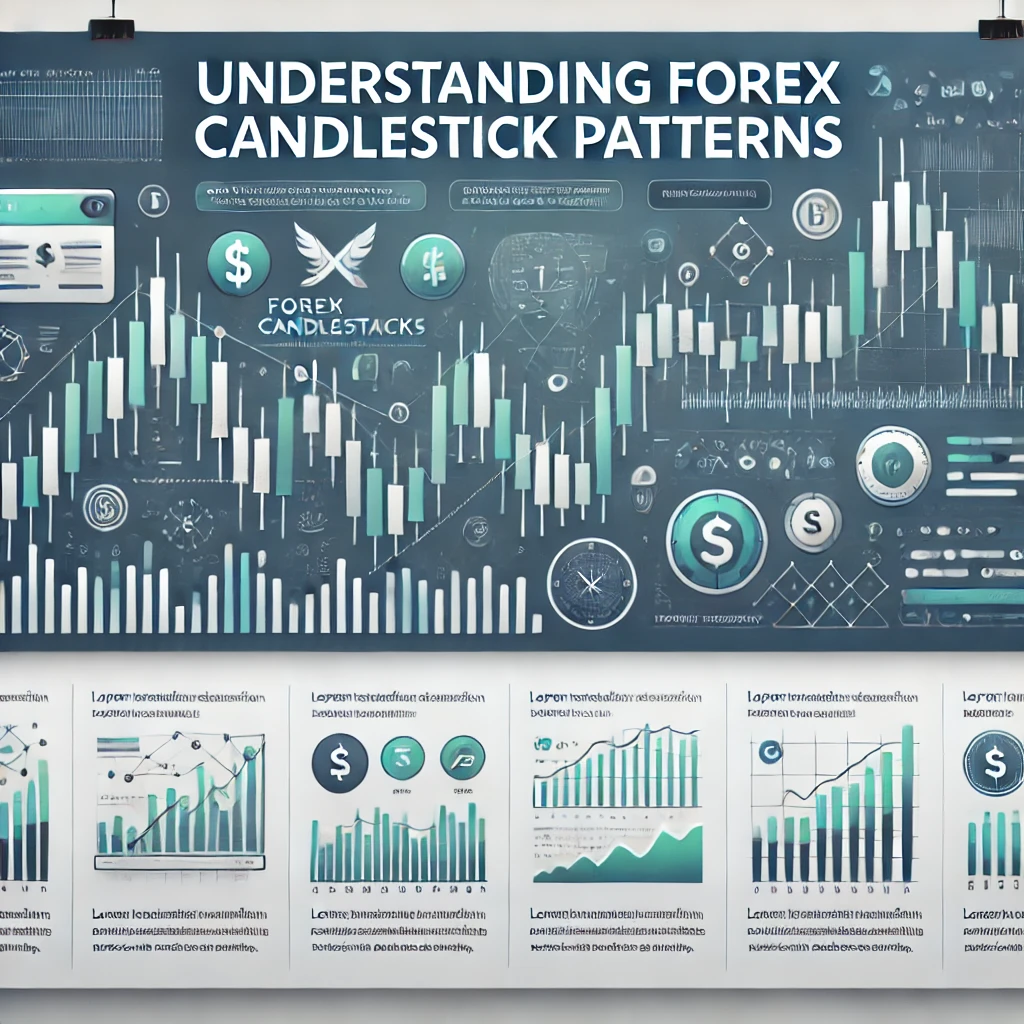
Understanding REITs: A Comprehensive Guide for Forex Traders
19/09/2024
How to Use RSI in Forex Trading
25/09/2024Understanding Forex Candlestick Patterns
Meta Description: Master the art of reading Forex candlestick patterns. Learn how these powerful tools help traders predict market movements and make informed trading decisions.
Understanding Forex Candlestick Patterns in Financial Markets and Forex Trading
Candlestick patterns are one of the most fundamental tools in Forex trading. They provide traders with visual insights into market sentiment, helping them predict future price movements. Whether you’re new to Forex or an experienced trader, mastering Forex candlestick patterns can significantly improve your trading strategies. In this comprehensive guide, we’ll explore the importance of candlestick patterns, break down the most popular formations, and provide tips for using them effectively in your trading decisions.

What Are Forex Candlestick Patterns?
Candlestick patterns are a type of chart used in Forex and other financial markets to represent price movements over a specific time period. Each candlestick on the chart represents four key pieces of data: the opening price, the closing price, the highest price, and the lowest price during the selected time frame. The body of the candlestick reflects the price movement between the opening and closing price, while the wicks (or shadows) represent the high and low points.
Candlestick patterns not only provide real-time information about price action but also help traders identify potential reversals, continuations, and consolidation phases in the market. Understanding these patterns allows traders to make informed decisions when entering or exiting trades.
Basic Anatomy of a Candlestick
Before diving into specific patterns, it’s essential to understand the structure of a candlestick. A typical candlestick consists of three main components:
- The Body: The body of the candlestick shows the price range between the open and close. If the closing price is higher than the opening price, the candlestick is typically displayed as green (or white), indicating a bullish trend. If the closing price is lower than the opening price, it appears as red (or black), signaling a bearish trend.
- The Wick (or Shadow): The thin lines extending above and below the body are known as wicks or shadows. These lines represent the high and low prices during the trading session.
- The Color: The color of the candlestick helps traders quickly understand the market sentiment. Green or white candlesticks indicate buying pressure (bullish), while red or black candlesticks indicate selling pressure (bearish).
Popular Forex Candlestick Patterns and Their Significance
Candlestick patterns come in various formations, each with its own significance. Traders often rely on these patterns to predict future price movements. Below are some of the most commonly used patterns:
Bullish Candlestick Patterns
- Hammer: The hammer is a bullish reversal pattern that forms at the bottom of a downtrend. It has a small body with a long lower wick, indicating that sellers pushed the price down during the session, but buyers regained control before the close.
- Trading Tip: Look for hammers near support levels as a signal of potential reversal and an opportunity to enter a long position.
- Bullish Engulfing: This pattern occurs when a small bearish candle is followed by a larger bullish candle that completely “engulfs” the previous one. It signals a shift in market sentiment from bearish to bullish.
- Trading Tip: Use the bullish engulfing pattern as a confirmation of a reversal in a downtrend. It’s often followed by strong upward momentum.
- Morning Star: The morning star is a three-candlestick pattern that signals the end of a downtrend. It starts with a large bearish candle, followed by a small indecisive candle, and concludes with a large bullish candle.
- Trading Tip: Wait for the third candle to close above the midpoint of the first bearish candle for confirmation of a bullish reversal.
Bearish Candlestick Patterns
- Shooting Star: The shooting star is a bearish reversal pattern that appears at the top of an uptrend. It has a small body and a long upper wick, indicating that buyers tried to push the price higher but were overwhelmed by sellers before the close.
- Trading Tip: Use the shooting star to identify potential short-selling opportunities, especially when it appears near resistance levels.
- Bearish Engulfing: This pattern is the opposite of the bullish engulfing pattern. It occurs when a small bullish candle is followed by a larger bearish candle that engulfs the previous one, signaling a reversal from bullish to bearish sentiment.
- Trading Tip: The bearish engulfing pattern often leads to further downward movement, making it a reliable signal for short trades.
- Evening Star: The evening star is the bearish counterpart of the morning star. It consists of three candles: a large bullish candle, a small indecisive candle, and a large bearish candle. It signals the beginning of a downtrend.
- Trading Tip: Look for the evening star pattern near resistance levels, as it often marks the end of an uptrend.
Continuation Candlestick Patterns
- Doji: A Doji is a candlestick with almost no body, indicating indecision in the market. It occurs when the opening and closing prices are nearly identical. While it doesn’t necessarily signal a reversal, it often precedes significant market movements.
- Trading Tip: Combine Doji patterns with other technical indicators like moving averages or support/resistance levels to confirm a potential continuation or reversal.
- Three White Soldiers: This is a bullish continuation pattern formed by three consecutive bullish candles with progressively higher closes. It suggests strong buying pressure and is a reliable signal of an ongoing uptrend.
- Trading Tip: Consider entering a long position after the formation of the three white soldiers, especially if supported by volume.
- Three Black Crows: The three black crows pattern consists of three consecutive bearish candles with progressively lower closes. It indicates strong selling pressure and the potential for further downward movement.
- Trading Tip: The three black crows pattern is often seen at the top of an uptrend and can be used as a signal to exit long positions or enter short trades.
How to Use Forex Candlestick Patterns in Trading
Understanding candlestick patterns is just the first step. To maximize their effectiveness, traders should consider the following tips:
- Combine Candlestick Patterns with Technical Analysis: While candlestick patterns are powerful, they become even more effective when combined with other technical analysis tools. For example, use moving averages, trendlines, and Fibonacci retracement levels to confirm the signals provided by candlesticks.
- Time Frame Matters: Candlestick patterns can appear on various time frames, from one-minute charts to daily charts. However, patterns that form on higher time frames (such as daily or weekly charts) tend to be more reliable than those on lower time frames.
- Practice Risk Management: Candlestick patterns do not guarantee success. Always use risk management strategies, such as setting stop-loss orders and maintaining a favorable risk-to-reward ratio, to protect your capital.
- Pay Attention to Volume: Volume is a crucial factor when analyzing candlestick patterns. Strong volume accompanying a candlestick pattern increases the likelihood that the pattern will result in a significant price movement.
Recent Trends in Forex Candlestick Patterns
In today’s highly dynamic Forex market, candlestick patterns continue to be a reliable tool for predicting price movements. Recent trends show that traders are increasingly combining candlestick analysis with algorithmic trading and artificial intelligence (AI) tools to identify patterns more efficiently.
AI-based trading platforms are now capable of scanning thousands of charts in real time, identifying candlestick formations, and executing trades automatically. While technology is enhancing the speed and accuracy of trading decisions, understanding the underlying logic of candlestick patterns remains crucial for human traders who want to maintain an edge in the market.
Conclusion
Forex candlestick patterns are an essential tool for traders seeking to predict market movements and make informed decisions. By mastering key patterns such as the hammer, shooting star, and engulfing patterns, traders can gain valuable insights into market sentiment and improve their trading outcomes. However, it’s important to remember that no pattern is foolproof. Combining candlestick analysis with other technical indicators and sound risk management strategies is key to long-term success in Forex trading.



